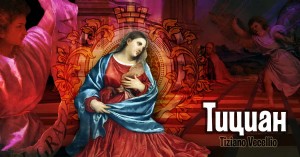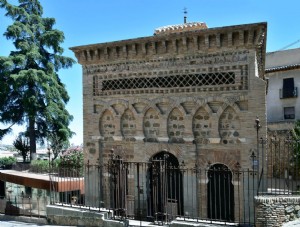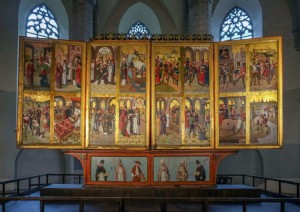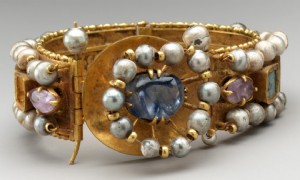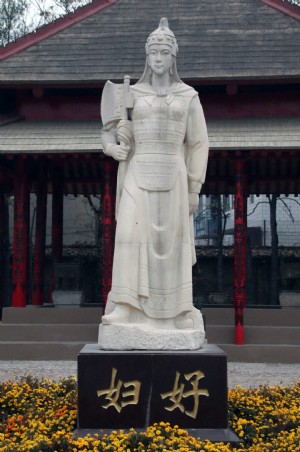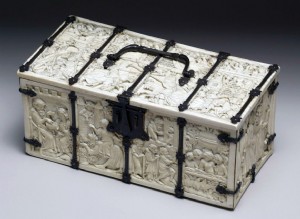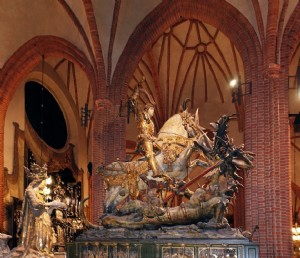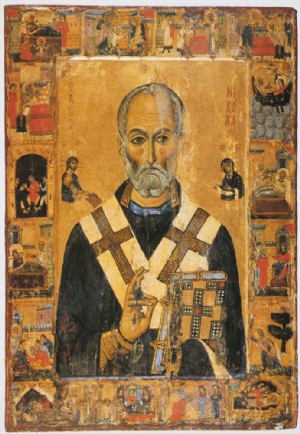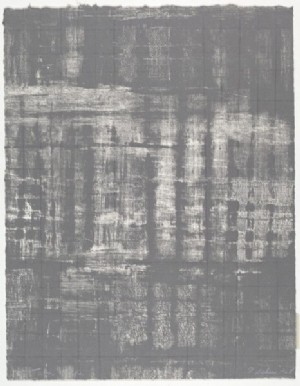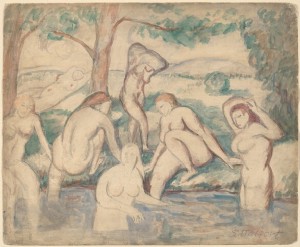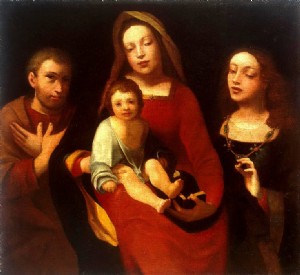Как и многие гении, опередившие свою эпоху, Анри Руссо при жизни не знал, ни слава, ни богатство. Талантливый художник, до 41 года проработавший обычным клерком в таможенном управлении Парижа, нашел в себе силу воли отказаться от привычного образа жизни и полностью посвятить себя живописи. Единственное, что поддерживало Руссо в его увлечении, - это непоколебимая вера в собственный талант, что позволило ему стать одним из величайших мастеров своей эпохи. Удивительно, стремление подражать техникам прошлого перенесло художника прямо в будущее - его творческая манера станет очень характерной для многих мастеров XX века. «Наивное» искусство Руссо, в ногу с импрессионизмом, вскоре отделилась в совершенно другую школу. Оригинальный стиль живописца, изобилует элементами фантасмагории, восхищались Пабло Пикассо и Робертом Делоне, давая самому Руссо лишь минимальные средства к существованию в течение его жизни.
Бурная молодость
Начав карьеру художника в возрасте сорока одного года, Анри Руссо был самоучкой. Приехав из провинции в Париж и поселившись там мелким чиновником, Руссо писал везде:дежурив на работе, пользуясь благосклонностью своего начальства, а ночью дома. Бедных, но терпеливый, скромный, но уверенный в своей гениальности, он стал одним из ведущих и признанных мастеров художественного авангарда, которым восхищались прогрессивные современники и поколения потомков.
Однажды сам Руссо написал автобиографическую заметку для книги «Портреты будущего века» - «Родился в Лавале в 1844 году в семье с отчаянно скромными доходами. он был вынужден посвятить себя не той профессии, что привлекло его любовью к искусству ». Правда, книга так и не вышла.
Отцом художника-самоучки был Жюльен Руссо - потомственный жестянщик из городка Лаваль на западе Франции. А его мать - дочь офицера Великой армии Наполеона. Отец Анри отчаянно хотел разбогатеть, следовательно, купив дом на окраине города, он оставляет свое ремесло жестянщика и пытается наладить бизнес по перепродаже различных товаров. Но, увы, его работа выгорела, и с тех пор безнадежная бедность поселилась в доме Руссо.
К счастью, несмотря на крайнюю нужду, семья будущей артистки смогла отправить единственного сына учиться сначала в школу, а потом в лицее. Анри был средним учеником, хотя ему удалось получить ряд школьных наград, отличился в пении и арифметике. Эти, казалось бы, незначительные достижения повсюду отмечаются в его биографии не потому, что Руссо стал всемирно известными художниками, а потому, что он также написал удивительный вальс, названный в честь своей первой жены - «Клеманс».
После тренировки, Генри устраивается на работу в адвокатское бюро, где он делает большую ошибку. В девятнадцать лет подстрекаемые его друзьями, Руссо крадет крошечную сумму денег из бухгалтерии, но этого достаточно, чтобы положить конец его адвокатской карьере и попасть под следствие. В суде, Генри должен согласиться на сделку - целых семь лет военной службы, всего на один год тюрьмы.
Полк Руссо, дислоцируется во Франции, никогда не примет участие в боевых действиях за границей. Даже когда Наполеон III отправляет французский военный корпус в Мексику, чтобы поддержать своего протеже Максимилиана в борьбе за императорский трон, будущий авангард в экспедиции не участвует. Несмотря на то что, гораздо позже, поэт Гийом Аполлинер (1880-1918) пишет стихотворение о пребывании Руссо в красочной стране ацтеков, художник никогда не пытается это опровергнуть, а также ряд других мифов о его жизни.
В 1868 г. отец Руссо умирает, и Генри, как единственный кормилец в семье, получает увольнение из армии. Покинув свой полк, который тогда находился в Париже, он с головой окунается в суетливую жизнь большого города. Прежде всего, молодой человек находит работу и снимает с себя жизнь, расположен недалеко от Ле Бон Марке, первый многоэтажный торговый центр во французской столице.
Юноша сразу влюбляется в дочь хозяйки дома, Мадам Буатар. В 1869 г. он берет в жены Клеменс Буатар. Несмотря на постоянную слабость (Клеманс болела туберкулезом), супруга помогает Анри зарабатывать деньги на жизнь, неутомимо занимаюсь шитьем на заказ. На выходных, любители часто гуляют в красивых парижских парках. Правда, счастье Анри и Клеманса омрачено тем фактом, что их дети умирают один за другим прямо в младенчестве.
Из семи детей любящих супругов, выживают только двое - дочь Жюли-Клеманс и сын Анри-Анатоль. Жена Руссо, постоянно мучается туберкулезом, была слишком слаба, чтобы сама заботиться о детях, поэтому с рождения их воспитывала няня, которая жила в пригороде Парижа. В 1888 г. Клеменс умирает. Анри Руссо никогда не забудет любимую жену. Даже при жизни посвятит ей вальс собственного сочинения, а после ее смерти он снова и снова будет создавать ее портреты.
Мелкое официальное живое искусство
Еще в 1871 г. молодой Руссо устроился на постоянную работу на таможню акцизного отдела, который в 19 веке собирал налоги с товаров, ввозимых в Париж. Досмотр товаров у городских ворот - занятие скучное и однообразное, но это не ограничивает внутреннюю свободу человека, выполняющего его.
Во время одной из следующих смен маленький клерк ставит мольберт прямо во дворе здания кафедры, и начинает рисовать. К несчастью, картины, написанные Руссо до 1877 года, не сохранились. Исключение только одно, изображающие батальную сцену на фоне местного пейзажа.
Скоро, знаменитый тогда художник Феликс Клемент (1826 - 1888), который помогал юному Руссо советом, знакомит начинающего художника с одним из представителей официального французского искусства той эпохи, Барон Леон Жером. После этого, Руссо арендовал свою первую мастерскую и в 1885 году поддержанный бароном, впервые выставил две свои работы в Салоне Отверженных.
Год спустя, в 1886 г., художник Поль Синьяк (1863-1935), интересуется творчеством Анри Руссо, предлагает ему принять участие в новой выставке. Синьяк считал, что лучшее место для работ такого оригинального художника - это Салон независимых художников. Создано представителями авангардного искусства. Дело в том, что все ранние попытки создать самостоятельные салоны заканчивались неудачей - как по волшебству, они стали напоминать официальный Салон, что не устраивало прогрессивных художников, которые чувствовали возрастающую потребность в отдельной выставке.
Для Руссо было очевидно, что официальные художественные круги, представленные Салоном, с его старой академической традицией, навсегда отказался бы от самоучки, хотя бы из принципа. Следовательно, с того времени и до самого конца, Анри Руссо останется верным новому «салону без жюри».
Уже в 1886 г. выставив четыре свои работы в независимом салоне, По достоинству оценят начинающего художника такие известные художники, как Поль Гоген (1848 - 1903) и Пюви де Шаванн (1824 - 1898), которые восхищались умением Руссо передавать драматические моменты с помощью множества оттенков черного. Но, В основном, его произведения остаются непонятными для публики, Более того - их высмеивают - ученые утверждали, что даже ребенок может так рисовать.
К счастью, Руссо был очень устойчив к сарказму и критике публики. Он даже заключает договор с Аргусом, согласно которому ему были отправлены все журнальные статьи и газетные вырезки, который содержал обзоры и комментарии к его работе. В ожидании всеобщего признания своего бесспорного таланта, художник педантично вставлял их в блокнот, который со временем стал толще. Из газет Руссо однажды узнает, что мэрия Парижа наградила его медалью. Счастливый, он немедленно приказывает отметить награду на своей визитной карточке, но позже выясняется, что он очень торопился:речь шла о другом художнике с таким же именем.
Обеспокоенный после смерти жены поиском средств для нормального содержания детей и покупкой красок, Руссо, в надежде заработать денег и быть впечатленным Всемирной выставкой в Париже в 1889 году, на которой Франция представила свою знаменитую Эйфелеву башню, артист снова обращается к музыке и пишет либретто для водевиля. К несчастью, это не принесло ни гроша.
После ухода со службы в 1893 г. после многих лет службы, Руссо получает мизерную пенсию и может только мечтать о времени, когда его любимое занятие - живопись, наконец-то начнет приносить достойный доход. В это время, Руссо вынужден давать уроки игры на скрипке и рисовать картины на заказ, продавая их по смешным ценам. Несмотря на то что, всего год спустя его работа «Война», экспонируется в Салоне Независимых, получает широкий отклик, особенно, писатель Альфред Джари (1873-1907) восхищается ею, с чьим светом, художник Анри Руссо получает прозвище «Таможенный служащий» (Le Douanier), закреплен за ним на всю жизнь.
Скоро, вся семья Руссо переезжает, кто где. В 1895 г. дочь художника уезжает с мужем в Анже, расположен на западе Франции, и художник вместе со своим сыном Анри-Анатолем переезжает жить на Монпарнас - знаменитый район на левом берегу Сены, который впоследствии стал излюбленным местом встречи творческого и интеллектуального авангарда. Там, на Монпарнасе, Руссо знакомится с Жозефиной Ле Тенсорер - женщиной, жившей по соседству, покорившей сердце художника. Надолго, Жозефина пренебрегла признаниями художника в любви и согласилась стать его женой только после безвременной кончины Анри Анатоля.
Как свободолюбивый масон, Анри Руссо все же женился в церкви со своей новой любовью в 1898 году. Финансовое положение семьи было довольно плачевным. следовательно, помочь мужу, Жозефина пыталась продать его работу в своем магазине канцелярских товаров, и художник, по очереди, продолжал давать платные уроки. Тем не менее, по воскресеньям, Руссо, несмотря на его нужду, в рамках Филотехнического общества, чьей главной целью было просвещение масс, учил всех, кто хотел рисовать акварелью, пастель а также, с гордостью и удовольствием, поделился опытом росписи фарфора и керамики.
Нищий гений
Всего пять лет спустя в 1903 г., художник становится вдовцом во второй раз, а также, пытаясь справиться с горем, он полностью посвящает себя работе. Я должен сказать, его карьера художника, наконец начал стремительно набирать обороты. В 1903 г. снова участвовал в двух художественных салонах - Независимых художников (в марте) и в первом Осеннем салоне, который открылся в октябре. Но живописец по-прежнему остро нуждается. К счастью, скромная, но щедрая папуасская семья, кто жил по соседству, часто приглашали его к себе на обед, и подруга Мари Биш, кто занимается мелкой торговлей, не раз помогает Руссо в критических финансовых ситуациях.
Перелом наступает только в 1906 году, когда художник встречает Робера Делоне (1885-1941) и поэта Гийома Аполлинера. Новые друзья открыто восхищаются талантом живописца, и Пабло Пикассо (1881–1973), случайно приобретя Портрет женщины Бриса Анри Руссо в 1908 году, организует пышный банкет в честь автора.
Один из друзей Пикассо, Фернанда Оливье, описывает Руссо:«Этот респектабельный, слегка сутулый мужчина, который скорее будет бегать трусцой, чем ходить, его волосы седые, но густые, несмотря на его возраст, имеет повадки мелкого рантье, и его лицо слегка испугано, но добрый. Он легко краснел, когда был смущен или когда кто-то возражал ему. Он соглашался со всем, что ему говорили, но чувствовалось, что он держится в стороне и просто не смеет выражать свои мысли. ”
Среди друзей Руссо был Альфред Джари (1873–1907), художник познакомился с ним в то время, когда последняя работа - «Король Убу» (1896), что сделало его известным основателем театра абсурда, еще не было написано. Возможно, именно страсть к шокированию и провокациям объединяет Руссо и Жари. По словам молодого писателя, наивное искусство таможенника, откровенный и бескомпромиссный, шокирует среднего человека. Один раз, Жари заказал живописцу свой портрет. Картина, к несчастью, не дошло до наших дней, но известно, что Руссо изобразил своего друга с хамелеоном и совой. Фрай был в восторге! Он платит Руссо деньги из родительского наследства и везде превозносит его талант. Художник очень дорожил этой дружбой. Именно он протянул руку помощи и приютил юного чудака, когда удача изменила его в 1897 году. и Жары, без гроша в кармане, оказался на улице.
Анри Руссо ясно понимал, детский голос, все считали его наивным и простым, но так ли это было на самом деле? Непоколебимая уверенность в собственном гении позволила живописцу стать целеустремленным человеком с необычайной выносливостью, и почти детская наивность - очень оригинальный художник.
В декабре 1907 г. Руссо, из-за его беспечности и легковерия, снова попал в тюрьму за мошенничество, несмотря на то что, по факту, он был его жертвой. Чтобы получить свободу, лишь бы по воскресеньям давать уроки благотворительности, художник пишет ходатайство в суд:«Обращаясь к вашей доброте, Прошу хотя бы условного освобождения, чтобы можно было продолжить работу. Прошу не разрушать мою карьеру, ради чего я так много работал. " К счастью, Просьба Руссо была удовлетворена после рождественских каникул.
Товарищеские уловки
По мнению современников, Руссо обычно работал в простой льняной белой рубашке, но всегда надевает костюм, когда устраивает приемы в своей мастерской. Немецкий коллекционер Вильгельм Угде, первым посвятил художнику целую книгу в 1911 году, был одним из завсегдатаев вечеринок для таможенников. Вот как он описал улицу, на которой находился дом Руссо:«Она всего несколько шагов в длину и упирается в каменную стену. Кажется, что мы где-то в провинции, а не в Париже. В комнатах на первом этаже хозяин живет с семьей, и выше - апартаменты гостей. На одной из дверей табличка - «Уроки риторики, Музыка, рисунок, сольфеджио ». Звоним и входим:нас встречает Руссо. ”
Почти каждую субботу вечером среди его картин и друзей, таможенник играет на скрипке для артистов, коллекционерам и просто ценителям искусства. Он снова влюблен, но Леония, вдова 59 лет, отказывается стать его женой. В эти вечера часто можно было встретить хозяина дома, в котором жил Руссо - господина Кеваля, спокойный респектабельный человек, коллега Руссо по работе в таможенном управлении Парижа. Среди гостей часто можно было увидеть Амбруаза Воллара, которые покупали картины художника и не раз приглашали его с собой на творческие вечеринки. Анри Руссо был на подъеме:наконец-то пришло время попробовать плоды многолетнего упорного труда - стабильное финансовое положение, всеобщее признание. Вот и здоровье… Художника давно беспокоят незаживающие раны на ногах, который, в конце концов, вызвал гангрену.
Блестящий художник, Анри Руссо скончался 2 сентября, 1910 г. в городской больнице Неккера в Париже. Похоронен в братской могиле. Роберт Делоне, Амбруаз Воллар и Поль Синьяк приехали в последний путь к художнику.
Год спустя, Делоне за свой счет организовывает перезахоронение останков художника. А Гийом Аполлинер напишет на своем надгробии сочиненную им эпитафию:«Прощай, наш хороший друг Руссо! Услышь нас - Делоне с женой, Кеваль и я. Кисти принесем, краски, и холст в подарок, чтобы вы писали портреты звезд на своем святом досуге. ”
Ранняя работа
Вглядываясь в первые картины Анри Руссо, один из критиков воскликнет:«Он искренний и наивный, чем-то напоминает примитивов ». Второй критик соглашается:« Картина довольно сухая и жесткая, но очень интересно, потому что его наивность приводит к идее итальянских примитивистов ». Даже насмешники и ярые противники оригинального творчества Руссо признавали мастера выдающимся примитивистом.
Хотя полотна «Прогулка по лесу» и «Встреча в лесу», художник все же ближе к национальной живописи эпохи рококо 18 века, чем к итальянским примитивам. Во многом это связано с хорошо заметным традиционным мотивом галантных сцен (fetes galantes), очень характерный для французского художника Антуана Ватто (1684-1721), картины которого выставлялись в Лувре. Кстати, именно их репродукции украшали стены мастерской Руссо.
Работы раннего периода у Руссо очень сильно отличали его от современников - импрессионистов. Это хорошо видно в сложной цветовой гамме картин «Встреча в лесу» и «Прогулка в лесу». в котором художник изображает настоящие и воображаемые деревья, используя большое количество различных оттенков коричневого и зеленого.
На первой картинке лес густой и непроходимый, во втором - светлый и прозрачный. Все дальние планы строятся туманными, мелкие штрихи, что облегчает зрительное восприятие, нейтрализуя слишком насыщенный темный лес. небо, занимая треть изображения, нарочито уменьшенные деревья вдалеке - все это говорит о попытке художника - самоучки как-то определить границы пространства, придать глубину, то есть, чтобы показать перспективу, что для Руссо лишенный академических знаний и навыков, был настоящим камнем преткновения. Возможно поэтому, позже он сознательно отказался от какой-либо перспективы в своих полотнах.
На картине «Встреча в лесу» влюбленные изображены верхом на лошадях и смотрят друг на друга. Они одеты в типичные костюмы 18 века. Длинные волосы женщины свободно распущены по плечам - мотив, который присутствует во многих женских образах кисти Руссо. Сила чувств, взаимные объятия, нежность в мужском взгляде создают явный эффект присутствия этой пары на полотне, несмотря на то, что их тела практически незаметны за буйной растительностью. Любить только в своем мире, они ненадолго показались из-за леса, и казалось, что они вот-вот снова исчезнут из поля зрения навсегда.
На полотне «Прогулка по лесу» мы видим женщину, очень похожую на Клеманс, она словно застыла - может быть, ее испугали несущиеся эхо кавалькады, тревожный шелест листьев или внезапный хруст ветки.
Женские образы
Женские образы, а также изображения животных, занимал огромное место в творчестве художника. Два больших женских портрета, нарисованный Руссо с небольшим промежутком, очень похожие композиции. На обоих изображены женщины в черном, стоящие в полный рост. Формат работ и позы персонажей позволяют отнести картины к жанру парадных портретов. Возможно, они оба были сделаны на заказ, хотя идентичность моделей оставалась неизвестной.
Первое полотно - «Женский портрет» (альтернативное название «Портрет миссис М.») было создано примерно в 1895 году. Именно эту картину за очень скромную цену в 1908 году приобрел другой гениальный художник - Пабло Пикассо (1881). -1973), который был в восторге от этого. Это произведение также известно как Ядвига, хотя нет никаких доказательств того, что название модели совпадает.
Существует легенда, согласно которой девушкой на холсте была красивая полька, очаровавшая художника. И хотя эта версия не имеет подтверждений, факт остается фактом:это имя нравилось Руссо. Сам он называл их главным героем пьесы собственного сочинения - «Месть русской сироты». Возможно, именно она воплотила для художника некий образ идеальной женщины. С тем же именем, Мастер назовет героиню другого своего полотна - «Сон» (1910).
Композиция первого портрета напоминает постановочную фотографию из магазина того времени. Женская фигура стоит на балконе, полном цветочных ваз, на фоне массивной занавески, окружен фантастическим пейзажем. В руках Ядвига ветка дерева. Эта деталь представляет особый интерес, поскольку является традиционным символом смерти. Это можно объяснить, если верить сторонникам теории реального существования этой женщины, которые утверждают, что на момент написания полотна Ядвига уже была мертва. Косвенно это предположение подтверждается тем, что художник выбрал для платья женщины черный цвет, что всегда подчеркивало особую драматичность изображаемой сцены.
Женщина на втором портрете изображена среди восхитительного разнообразия зелени. Ее рука лежит на бедре, и ее ноги, выглядывающие из-под платья, едва касаются земли, что создает иллюзию движения. Внизу холста мы видим котенка, играющего с клубком ниток, придание живости и непосредственности официальному тону портрета.
Руссо заканчивает свою знаменитую работу «Спящая цыганка», также посвящена женскому образу, всего через месяц после смерти единственного сына, Анри Анатоль.
В 1897 г. выставлял работы в Салоне независимых, сопровождая его надписью на рамке:«Хищник, переполненный жаждой крови, застывает на месте, не смея напасть на крепко сонную жертву ». Фигура цыганки с шарфом и яркой одеждой, резко контрастирующий с смуглым цветом лица, немного напоминает восточных женщин с картин академических художников. Именно эту работу Руссо активно предлагал приобрести меркам своего родного города Лаваля, в память о себе.
Художник даже написал мэру города:«Здесь все залито лунным светом». Конечно, мэрия отклонила его предложение. Работа исчезает и вновь открывается только в 1923 году и, поскольку не все картины Руссо были широко известны, вызывает множество споров и слухов. Многие считают это подделкой, шутка, которую приписали другому художнику - Дерену. Тем, кто не сомневался в истинном авторстве картины, расценил это как очень решительный шаг художника от реализма к сюрреализму.
Скоро, Руссо отошел от импрессионистов, хотя он по-прежнему разделял их неприязнь к традиционным канонам изобразительного искусства. Импрессионизм предполагал творческую свободу, которая была так необходима Руссо. Его искусство, основанный на совершенно плоской интерпретации всех форм, не только не учитываются стандартные правила изображения перспектив, принятые в эпоху Возрождения, но и сознательно ими пренебрегает. Художник упрощает форму, создавая свой неповторимый стиль живописи. Настоящие пропорции здесь искажены, цветовая проработка объема отсутствует, а тени вообще не существует. Руссо не хотел изображать скучную и приземленную действительность, пропуская через его богатое воображение все образы и формы.
Искусство художника очень похоже на декоративные росписи с разноцветными фигурами гладкой фактуры и незамысловатой формы. Его картина «Ребенок с марионеткой» производит странное впечатление, вызывающее содрогание. The master first delineates the contours of the figure of a child resembling a porcelain doll, leaving it itself unwritten, then works on the background of the picture and returns to the figure again. Rousseau, like Emil Bernard (1868 - 1941) and Paul Gauguin, completely ignores the principles of classical perspective. Кроме того, the painter gives a clear preference to substantive conventions, rather than boring specifics.
Children’s portraits
Brushes Russo own many children’s portraits. It is not known why the theme of children was so important for the artist, if they were custom-made works, if the artist felt the loss of his six children. The exact answer to this question is unknown, we can only assume that, portraying children, the painter tried with the help of paints, brushes and imagination to bring back to life the images of his loved ones. Many of Rousseau’s portraits of children are in large format.
Например, a child in a red dress looks so large that it feels as if his figure hardly fits on the canvas. Apparently, the child is sitting:legs bent at the knees and almost hidden in the grass speak about this. The figure itself seemed to hover between heaven and earth, which imperceptibly smoothes the feeling of excessive massiveness. Like “The Child with the Puppet, ” the kid in this picture also holds a strange doll in his hand, resembling an adult with facial features.
In another picture of the same period - “Peasant Wedding”, we see a bride who looks at us with humble reverence. The figures of the people around her are so flat that they seem to be separately cut out of colored paper and glued to the background landscape. Even in spite of the trees carefully arranged by the letter “V” and some awkward dog located in the foreground, which theoretically should have been a compositional designation of the perspective, they could not erase the collage impression made by this painting.
The bride’s figure is the undisputed dominant of the picture, it is she who, with her snow-white belt, seems to connect the remaining characters into a single group. On the canvas, the artist symbolically indicated the continuity of generations, with the help of a long veil of the bride, slightly covering the elderly woman sitting nearby, who is obviously the grandmother of the bride or groom. The figure of an old man sitting separately from the group of main characters, whose legs are hidden in the grass, conjures up thoughts about the connection between modernity and eternity, life and death, earth and sky. The solemnity with which the whole group is located under the trees again reminds of a 19th century shop. It was in such static poses that people froze in front of a photo lens against the background of painted flat scenery:“We don’t move! Do not breathe! ". It’s possible that while working on the “Wedding”, the painter drew inspiration from some photograph, but nothing is known about the reasons for his appeal to this topic, as well as about the personalities of the prototypes of the characters. Although the man standing to the right of the bride remotely resembles the artist himself.
Symbolic works
In 1906, Henri Rousseau presented to the public his new work - “Freedom, calling for painters to participate in the 22nd exhibition of Independent Artists”, который, even being in the exhibition of the Salon of Independents, causes visitors to laugh only. Only a close circle of friends admires the new work of the artist, while the rest can not understand either the design itself or the ways of its implementation.
Friend of the painter - Robber Delaunay exclaims:“In another era, he would have painted the walls of the palaces by order of patrons. In ours, he is forced to be a jester for the inhabitants, he is so serious, so calm. What a senseless irony of fate! ” Russo celebrates the Salon with his new work, which made him a full-fledged artist, in every sense of the word. The compositional center of work is the allegorical figure of Liberty, depicted in a manner reminiscent of the academic. She plays the trumpet, traditionally a symbol of worship.
A year later, Rousseau again amuses the audience in the Salon of Independents with his work “Foreign representatives arrived under the banner of peace to salute the Republic”. On the canvas, we recognize the six presidents of the French Republic (dressed in black) standing on the podium, the Russian emperor (in a yellow and blue uniform), the king of England (on the left side), and also on the right:Franz Joseph from Austria, Peter I from Serbia, William II from Germany, Leopold II from Belgium, George I from Greece, the Persian Shah and King of Ethiopia. The republic, in red robes and a Phrygian cap (the headdress of the era of the French Revolution of 1789) triumphantly rises above all, holding an olive branch in outstretched hand. This multicolored extravaganza, colored by foreign flags, passes under the slogan written on three black pedestals standing in the foreground of the canvas:“Work, freedom, равенство. ” And in the background we see people gathering in a circle to start their holiday dance.
The artist was very fond of allegories, so popular among representatives of political circles. Repeatedly Rousseau took part in various competitions, which from time to time are arranged by the Paris authorities in order to decorate the premises of various departments. The painter always wanted to receive an official order, well paid and prestigious, because, в первую очередь, he constantly felt the need for money, а также, secondly, he still dreamed of universal recognition.
Тем не мение, the Customs Officer has failed to conquer either one or the other. Кроме того, all the time there were people who used this artist’s weakness and his inherent naivety to repeatedly play poor Rousseau. It even came to the point that the painter almost went to the Champs Elysees to personally thank the President of the French Republic for awarding him with his main state award - the Order of the Legion of Honor, the award of which was announced to the artist by evil jokers.
Exotic India
Once, the mother of the artist Robert Delaunay, succumbing to the entreaties of her son, decided to order a Russo painting. Her stories about an exotic trip to India inspired the Customs Officer to create a canvas designed in rich green tones typical of the tropical jungle. In the center of the picture we see the figure of a black-haired woman - a snake charmer, who is very reminiscent of an ancient mystical deity. Black snakes, as if mesmerized by the magical sounds of her pipes, slowly creep out from everywhere, and if at first glance they are barely distinguishable, then when the look gets used to a variegated variety and begins to distinguish details, you see them more and more. Amazingly, their movement on the canvas is felt almost physically. The eyes of the female figure, which are the only bright spot in the picture, add a mystical shade to the canvas, their tremendous attractive power is striking.
A river illuminated by a full moon, a thick and mysterious veil of plants shimmering in all shades of green, an exotic pink bird, brightly shining yellow flowers - the whole scene exudes incredible paradise and tranquility. The vertical lines of the figure and the plants surrounding it are softened by horizontal rays of light coming from the month. This fundamentally distinguishes the composition of “The Enchantress” of Rousseau from his “War”, where the horizontal construction of the entire canvas creates the effect of decay and symbolizes destruction and destruction.
Unpleasant Surprise is somewhat close to Snake Charmer. In this picture we see a woman scared by a bear. The figure of the woman again resembles the mythical goddess, or Old Testament Eve, lost in the Garden of Eden. Her round hips are slightly covered by hair falling down to her knees. As in The Caster, the woman is surrounded by the same bizarre trees with bright foliage, and in the background - on the shores of a magical lake, depicting dense forests of bizarre trees. And in the depths, the figure of a lurking hunter is hardly noticeable. When you see her, the soul becomes calm - he will certainly shoot and save the woman from the predator.
Contemporaries will write down a statement by an Italian critic dedicated to Rousseau:“He lives in a strange world, fantastic and real at the same time, close and far, sometimes funny, sometimes tragic. He loves a riot of colors, fruits and flowers, wild animals and fabulous birds. He lives, working unconscious, focused and patient, met with ridicule and unfriendly shouts every time he decides to break his loneliness in order to present his creation to the world. ”
Buddy portrait
The hero of the picture “Chaise of Father Juniet” (1908) is a real character - a seller of vegetables, a former friend of Rousseau (though his real name was Claude Junier). His shop on Montparnasse was located just a few meters from the painter’s workshop. Junier always helped an artist who often lacks money for products. Sometimes Junier, along with his friends, took Rousseau to ride on his chaise, which served him for the transport of goods. Juniera’s pet - a mare Rosa pulled a chaise. The seller of vegetables had a great weakness for horses and dogs, one of which is shown in the picture next to the chaise.
When creating the canvas, the artist used a photograph taken in Klamar in 1908. Rousseau transferred the composition of the photograph to the canvas, adding to it a dog on the road and several figures. While the painter was working on the painting, his workshop was visited by the American artist Max Weber (1881-1961). Considering the work, Weber drew the author’s attention to the imbalance in size between dogs and other objects and characters. Rousseau replied:"Everything must remain as it is."
Perhaps the artist is right, relying only on his own vision, because when you look at this work for a long time, it starts to seem that it is this absolutely disproportionate, and therefore some mysterious dog that gives the picture a touch of fabulousness. It is the altered proportions and disturbed perspective, abundantly supplemented by elements of phantasmagoria, that give Rousseau’s everyday scenes this element of attractiveness and mystery.
Five people and a dog are sitting in a chaise. All of them are depicted facing the viewer, as if lined up in a line, like a group from the canvas "Peasant Wedding", but at a clear angle with respect to the seats of the chaise and the direction of the road. The canvas has an impressive size, very characteristic of works of decorative art, and this, according to critics, makes it similar to the "tapestries of a thousand flowers" - magnificent carpets popular in the 15th century on which colorful ornaments were woven from fancy plants.
В первый раз, the artist uses an absolutely smooth canvas in the painting, thanks to which the strokes are almost invisible. The whole color of the picture is clearly divided into two scales:black, white and red in the foreground, and ocher, green and blue - on the "backdrop".
City landscapes
Less well-known but no less significant part of Rousseau’s creative heritage is urban landscapes. Numerous types of Paris and its suburbs were in high commercial demand, следовательно, the artist, constantly constrained by the means, had to write them tirelessly. In those distant times, the outskirts of Paris were still little built up and literally buried in the pristine greenery of forests. The artist did sketches for future paintings immediately with oil paints, without using gouache or charcoal. He confidently writes from life, directly on canvas, only sketching from time to time.
Prescribing individual fragments in the open air with sweeping sharp movements of the brush, Rousseau completes the picture already in the workshop, carefully finalizing the details of each component. Two of the most famous examples of urban landscape in the work of Rousseau are the canvases “Furniture Factory in Alfortville” and “View from the Sevri Bridge”. On them, the painter depicted a free interpretation of the factory for the production of armchairs and chairs in Alfortville and one of the districts of Sevri on the southwestern outskirts of the French capital.
The Furniture Factory in Alfortwigle was written ten years earlier than The View from Sevri Bridge. When you look at the picture, the sky immediately catches your eye, with bizarre clouds on it. On the left is a river, and in the background is a bridge. But both elements are, скорее, of secondary importance. All the compositional construction of the painting comes from the wavy sidewalk, which unexpectedly creates the impression of the right perspective, rare for Russo’s paintings. The factory building itself strongly resembles a cardboard house from theatrical scenery, and figures of people around look unnatural. All this makes the scene very conditional, almost surreal.
A striking element of the picture is the figure of a fisherman in the foreground. Initially, his image was only a compositional necessity. Тем не мение, after the character was completed, the artist discovered that this fisherman, waiting for the bite, symbolizes a certain existence outside of time and space, thus embodying eternity in the picture. It is this distinctive approach to the depiction of time that sharply distinguishes Rousseau from the Impressionists, who were characterized by admiring a moment taken separately from life.
The compositional center of the second picture is the bridge over the Seine, which connects its wooded shores. The black and white boat, located in the foreground, is very expressive, its hull is strangely similar to the face of a man. Small figures of pedestrians merge with houses shaded by red foliage. Red and gray-green roofs perfectly match the gamut of the autumn landscape. A balloon, a hang glider and an airplane symbolize the three epochs of conquering the sky, which were often mentioned in the press of that time, and which Rousseau himself admired.
Мечты
In 1910, Henri Russo creates his greatest masterpiece - the canvas "Dream", exhibited by him in the same year at the 26th Salon of Independents. All his friends and colleagues unanimously claim that the work is worthy of the best reviews. The poet Guillaume Apollinaire writes about her in one of his articles:“I think that this year no one dares to laugh. You can ask the artists - everyone is unanimous, everyone admires them, even this sofa in the style of Louis - Philippe, lost in a virgin forest. And they are right. ”
Russo supplies the work with the following comments:“Jadwig has a magical dream. She quietly fell asleep to the flute of an unknown seducer. When a month casts light on flowers and green trees, животные and even predators, freeze, listening to the wonderful sounds of music. ” Andre Breton (1896 - 1966) will note, a few years later:“I am close to saying:this great canvas absorbed all the poetry and all the secrets of our time. It is characterized by the inexhaustible freshness of discoveries… "
The painting "Dream", which has become one of the last works of Russo, is considered the will of the artist. Intertwined, the plants create an illusion of space on the canvas, which is echoed by the whole color scheme of the picture. The feeling of depth is emphasized by iridescent shades of green. Monkeys frolic in bizarre branches, where bright exotic birds are seen everywhere, and below, under them, predators roam in the grass. Only a black musician stands in the thick grass and plays his flute, as if not noticing anything around. Both characters and plants are torn from real space, their characteristic form and their true condition, but they are all written out so carefully that they look incredibly plausible. As if anticipating his demise, Henri Russo leaves us a legacy of a true paradise.With his “Dream”, the artist illuminated the coming generation with the road to surreal art, ahead of his time.
In the same 1910, Rousseau painted another picture - “The attack of the jaguar on the horse”, bought later by the patron Ambroise Vollard. The artist himself was proud of the work. “Twenty-two shades of green!” - the painter proudly told the famous Italian critic Argendo Soffichchi, who came to him to look at a new work. Sofficchi was shocked by the picturesque manner of Rousseau. After drawing with a pencil all the contours of exotic plants, the artist applied various shades of green in separate strokes, prescribing each fragment several times, and carefully cleans the palette with each color change.
Among strangers
Despite the fact that Rousseau’s personal sympathies were always on the side of academic painting, he received recognition only among the most progressive contemporaries - avant-garde artists were his best friends all his life. The creative manner of the artist himself is attributed to primitivism, thanks to his original style and because of his love for Italian primitive artists, such as Fra Angelico (c. 1400 - 1455) and Giotto (1267 - 1337), who worked in the XIV and XV centuries, when the laws of a classical perspective had not yet been discovered, the absence of which would become a real hallmark of all of Rousseau’s work. “Only in 1885, after numerous disappointments, was I able to devote myself to art, studied myself, learned nature and took the advice of Jerome and Clement, ” says Henri Russo about himself.
In search of his own style, Russo worked a lot in the Louvre, creating copies of the masterpieces of the great masters of the past. The painter received permission to work in the famous museum thanks to his friend Felix Clement (1826 - 1888), кто, like Rousseau himself, was a self-taught artist. Но, unlike the Customs officer, Clement was recognized and kindly by the authorities. Он, the lucky winner of the Roman Grand Prix of the French Republic, was paid for accommodation and training in Italy. The intelligent Clement, a devoted friend and delicate adviser, never allowed himself to be ridiculed or mocked at Rousseau and his paintings. On the contrary, he always insisted that the artist remained faithful to his style and did not turn off the chosen road. Clement introduces the Customs Officer to Leon Jerome (1824 - 1904), who worked at that time on the artistic embodiment of the lofty scenes of ancient mythology and ancient Eastern plots. Jerome - the star of official art - belonged to a group of artists - pompiers, named for their pompous luxury inherent in their canvases and pretentious splendor, and for the characteristic headdresses of their ancient heroes, reminiscent of helmets of firefighters (pompiers).
With rare exceptions, such as Clement and Jerome, Russo’s friends belonged mainly to the circle of Independent Artists. It was the representatives of neo-impressionism, in particular Georges Cera (1859 - 1891) and Paul Signac (1863 - 1935), who were the first to recognize a brilliant and original master in Rousseau in 1886. Signac highly appreciated his talent as a colorist, and Camille Pissarro (1831-1903) was loudly admired by the artist’s works, recognizing that it was precisely “feelings in the first place”. Robert Delaunay, the former, together with his wife Sonia (1885 - 1979), one of the founders of abstract art, expressed their admiration for the artist.
Delaunay and Russo become friends, despite the fact that the Customs officer does not always penetrate the essence of the creative research of his friend. “Why did Robert break the Eiffel Tower?” - Rousseau’s sincere question regarding the painting by Delaunay led to the appearance of the legend about the Customs officer as a naive genius who never really understood the figurative techniques of avant-garde art.
The author of this, like many other legends about the artist’s life, was the modernist poet Guillaume Apollinaire. He created myths about Rousseau, passing through his poetic imagination the story of his life, and the artist, по очереди, immortalized his image on canvas. Apollinaire described the process of writing his own portrait:“First of all, he measured my nose, рот, my ears, my forehead, my arms, my whole body and very accurately transferred all these measurements to his canvas, reducing it in accordance with the size of the frame. (…) I did not move, watching with admiration how anxious he was towards the work of his imagination, not allowing anyone and anyone to interfere in the creative process, so as not to disturb the harmony of the picture. And how mathematically accurately he depicted the figure of a man! If my portrait had nothing in common with my appearance, this would not have happened through the fault of Rousseau, but due to some annoying calculation error. Тем не мение, even those who are not familiar with me recognized me in the picture. ” In the role of the poet’s muse, the canvas depicts the artist and Apollinaire’s close friend, Marie Lorensen (1883 - 1956).
An evening in the history of art
Here is an example of one of the stories related to the life of Russo and his friends. One January evening in 1908, Rousseau and Apollinaire appeared in Bago Lavoir, where Pablo Picasso (1881 - 1973), an artist from Catalonia, set up his workshop in a small wooden house. The customs officer, wearing a soft felt hat, takes pride of place at the table, leaving outer clothing and a cane at the door. On the wall hangs the work of the self-taught artist "Portrait of Mrs. M." (that same mysterious "Jadwiga"). The wall itself is decorated with flags, lanterns and a large poster with the inscription "In honor of Rousseau." The guests present are all in high spirits, some have already visited the nearby tavern.
Apollinaire solemnly recites the ode he wrote for this evening:“We have gathered to honor you with wine, which pours Picasso. There is reason to drink, and we will drink and rejoice:“Long live Rousseau!” Around the table gathered:artists Georges Braque (1882 - 1963), Marie Lorensen and Andre Derain (1880 - 1954), writer Andre Salomon, poet Max Jacob (1876 - 1944) and two American women - the famous writer Gertrude Stein (1874 - 1946) and Alicia Toklas. Wine flows like water, Rousseau takes the violin and plays the waltz that he once wrote for Clemence. Then he comes to Picasso and quietly says in his ear:"We are the two greatest artists of the era." Then Apollinaire gets up again and reads a poem telling about Rousseau’s trip to Mexico invented by him:“Do you remember, Rousseau, the Aztec landscape? Forests where pineapples and mangoes grew, Merry monkeys, watermelon pulp, Race warmed the emperor Maximilian? "Your paintings come from Mexico, Where the burning sun and the riot of nature." An artist who has never been to this country does not even try to object, because today is the long-awaited day of his triumph.
Потом, a friend of Picasso, Fernanda Olivier will argue that the festive reception in Bateau Lavoir was a joke, a hoax. Тем не мение, Andre Salomon writes in his memoirs:"In Bato Lavoir, we had only one task - we wanted to give Rousseau the holiday he deserved." This technique in Bato Lavoir was one of the key moments in the history of the development of modern painting:it was there that two generations of artists met, thanks to whom new art was born.

